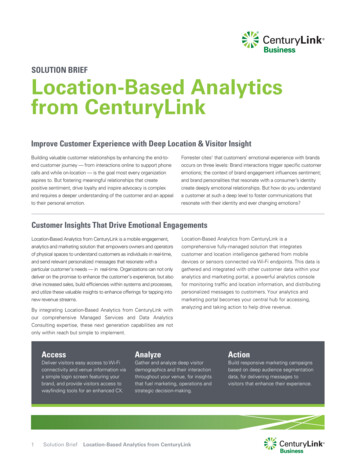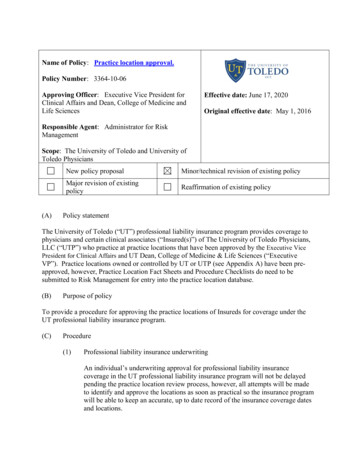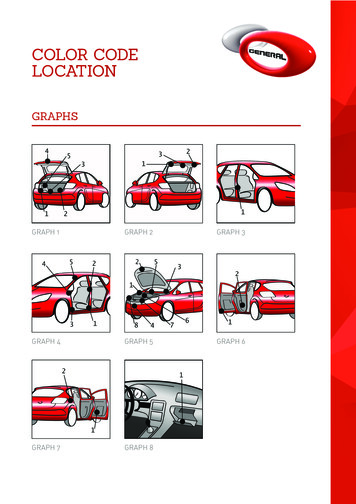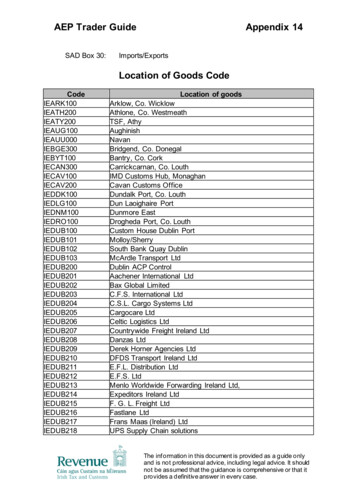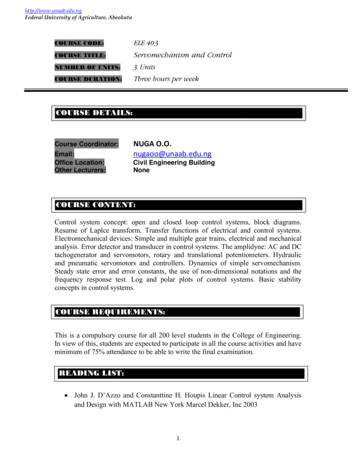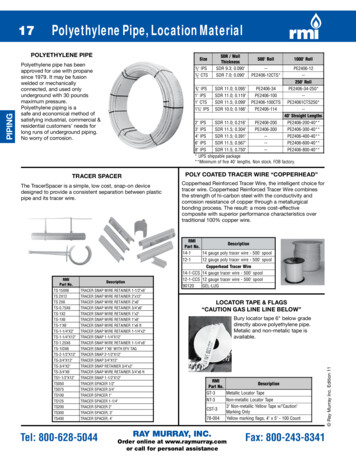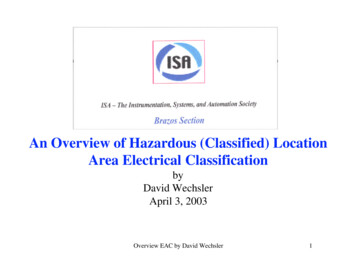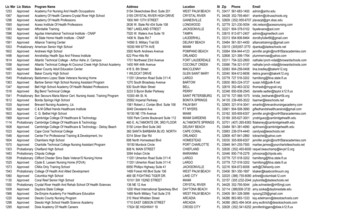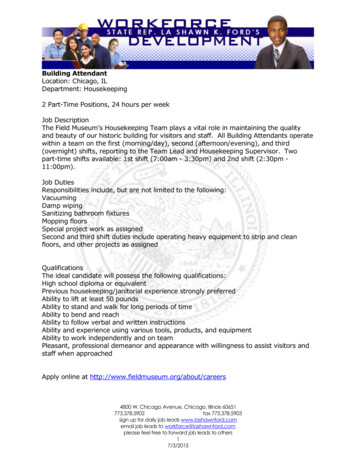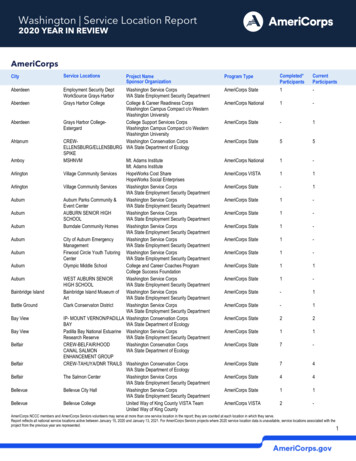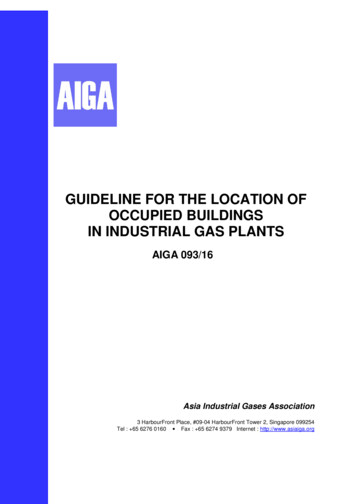
Transcription
GUIDELINE FOR THE LOCATION OFOCCUPIED BUILDINGSIN INDUSTRIAL GAS PLANTSAIGA 093/16Asia Industrial Gases Association3 HarbourFront Place, #09-04 HarbourFront Tower 2, Singapore 099254Tel : 65 6276 0160 Fax : 65 6274 9379 Internet : http://www.asiaiga.org
AIGA 093/16GUIDELINES FOR THE LOCATION OF OCCUPIEDBUILDINGS IN INDUSTRIAL GASES PLANTSAs part of a programme of harmonization of industry standards, the Asia Industrial Gases Association (AIGA)has issued this publication 93, Guidelines for the Location of Occupied Buildings in Industrial Gas Plants, jointlyproduced by members of the International Harmonisation Council and originally published by the CompressedGas Association(CGA) as P-64-2014, Guidelines for the Location of Occupied Buildings in Industrial GasPlants.This publication is intended as an international harmonized publication for the worldwide use and application byall members of the Asia Industrial Gases Association (AIGA), Compressed Gas Association (CGA), EIGA, andJapan Industrial and Medical Gases Association (JIMGA). Each association’s technical content is identical,except for regional regulatory requirements and minor changes in formatting and spelling.DisclaimerAll publications of AIGA or bearing AIGA’s name contain information, including Codes of Practice, safety procedures and othertechnical information that were obtained from sources believed by AIGA to be reliable and/ or based on technical information andexperience currently available from members of AIGA and others at the date of the publication. As such, we do not make any representation or warranty nor accept any liability as to the accuracy, completeness or correctness of the information contained in thesepublications.While AIGA recommends that its members refer to or use its publications, such reference to or use thereof by its members or thirdparties is purely voluntary and not binding.AIGA or its members make no guarantee of the results and assume no liability or responsibility in connection with the reference to oruse of information or suggestions contained in AIGA’s publications. Reproduced with permission from Compressed Gases Association Inc. All rights reserved.ASIA INDUSTRIAL GASES ASSOCIATION3 HarbourFront Place, #09-04 HarbourFront Tower 2, Singapore 099254Tel: 65 62760160 Fax: 65 62749379Internet: http://www.asiaiga.org
AIGAContentsAIGA 093/16Page1Introduction. 12Scope . 13Definitions . 24Building siting study methodologies . 44.1General information . 44.2Introduction to consequence-based analysis . 44.3Introduction to risk-based analysis . 54.4Introduction to overpressure concepts . 54.5Portable versus permanent buildings . 65Selection of buildings for consideration in the building siting study. 75.1Preliminary considerations . 75.2Buildings that should be included in a building siting study . 75.3Buildings that may be excluded from a building siting study . 86Selection of scenarios for consideration in the building siting study . 86.1Introduction to scenarios . 86.2Vapour cloud explosion . 86.3Process deviations . 106.4Pressure vessel mechanical failure . 116.5Exposure from neighbouring facilities . 137Determining the consequences of included scenarios . 137.1Decision on the type of analysis . 137.2Simplified approach for locating portable buildings . 137.3Consequence-based methodology . 147.4Risk-based methodology . 168Documentation and revalidation of building siting study . 208.1Documentation . 208.2Revalidation . 208.3Management of change. 209References . 2010 Additional references. 23FigureFigure 1—Pressure wave illustration . 6AppendicesAppendix A—Occupant vulnerability probabilities . 24Appendix B—Overpressure versus distance curves for vapour cloud explosions . 26Appendix C—Gamma factors for various materials in ASU and HYCO plants . 27Appendix D—Pressure volume energy . 29Appendix E—Worked example for a HYCO plant . 31Appendices FiguresFigure A-1—Probability of occupant vulnerability in psi . 24
AIGA.AIGA 093/16Figure A-2—Probability of occupant vulnerability in mbar . 25Figure B-1—Side-on overpressure versus distance for hydrogen using multi-energy correlationat explosion strength 5 . 26Figure B-2—Side-on overpressure versus distance for hydrogen using multi-energy correlationat explosion strength 7 . 26Figure C-1—Gamma factors for typical industrial gas materials at 70 F, 1500 F, and –200 F . 27Figure C-2—Gamma factors for typical industrial gas materials at – 123 C, 21 C, and 827 C. 28Figure D-1—Overpressure versus P V / (Gamma-1) factor for gases in psi and ft3 . 29Figure D-2—Overpressure versus P V / (Gamma-1) factor for gases in bar and m3 . 29Figure D-3—Overpressure versus P V / (Gamma-1) factor for 50% liquid full steam vessel in psi and ft3 . 30Figure D-4—Overpressure versus P V / (Gamma-1) factor for 50% liquid full steam vessel in bar and m3 . 30Figure E-1—HYCO plot example . 31Figure F-1—ASU plot example . 38Figure G-1—Risk assessment methodology flowchart . 43Appendices TablesTable E-1—HYCO consequence-based analysis worked example . 33Table E-2—HYCO risk-based analysis worked example . 36Table F-1—ASU risk-based analysis worked example . 40
AIGA.1AIGA 093/16IntroductionIncidents have shown the need for the chemical industry to consider the location of both permanent andportable occupied buildings on chemical production facility sites. The ignition of flammable vapour released intoa congested process area or pressure energy released from process equipment failures can impact personnellocated inside these buildings. Industry groups such as the American Petroleum Institute (API), the Center forChemical Process Safety (CCPS), and the Chemical Industry Association (CIA) have developed guides toassist these industry companies in the safe location and design of occupied buildings to improve the safety ofworkers. In some regions, assessing the risk to occupants in buildings within air separation unit (ASU) facilitiesis not specifically required by regulations.This publication is intended to provide guidance specific to the industrial gas industry for the determination oflocation and design of both permanent and portable on-site occupied buildings to address the risks in ASU andHYCO plants.The goal of this publication is to provide guidelines to:–protect the building occupants so the building does not place the occupants at greater risk than employeeslocated outside; and–reduce the risk to employees not essential to the operation of the facility by locating such employees in abuilding that is either:–away from the process; or–reinforced and/or equipped to achieve comparable risk reduction to that achieved by distance alone.Risk management and process safety assessment are complex subjects. Technology for determining the location of occupied facility buildings is still evolving. Some aspects of this technology require the application oftechnical judgement as well as proven scientific methodologies. It is the intention that this publication be usedby qualified personnel. Qualified personnel are those who have sufficient training and experience in hazardidentification and risk assessment.While this publication is intended to provide an overview of the processes and evaluations used to determinesafe location of occupied buildings, it is not intended to be a strict, prescriptive requirement. As individual company processes, risk targets, facility layouts, and safety procedures vary, each facility should be evaluated individually to ensure safe location of occupied buildings.2ScopeThis publication addresses the risks to persons in occupied buildings within ASU and HYCO facility boundariesassociated with pressure energy. Pressure energy can be generated from ignition of flammable material thathas been released into congested or confined area and the sudden failure of pressure vessels. Section 6.4provides criteria for the exclusion of specific pressure vessel mechanical failures from consideration.This publication is intended to provide guidance on determining the risk to persons in:–new permanent or portable occupied buildings on ASU and HYCO facilities;–existing occupied buildings from a new ASU plant, HYCO plant, or major modification added to an existingfacility;–an occupied building from a relocated ASU plant, HYCO plant; and–a relocated occupied building.It is also intended to provide guidance on how to address hazards from neighbouring facilities during the designof new ASU and HYCO plants. The provisions of this publication are effective as soon as hazardous materialsare introduced into the ASU or HYCO facility.1
AIGA.AIGA 093/16The scope of this publication is not intended to cover the following:–Existing buildings in existing ASU and HYCO plants;–Occupied buildings beyond the ASU or HYCO facility boundary, as this publication is specific to on-siteimpacts within ASU and HYCO facilities. CCPS Guidelines for Facility Siting and Layout, the Seveso III Directive, and other sources provide general guidance on this topic [1, 2] 1;–The location and design of occupied buildings as related to exposures from toxic gas releases.API RP 752, Management of Hazards Associated with Location of Process Plant Buildings,
API RP 752, Management of Hazards Associated with Location of Process Plant Buildings , API RP 753, Management of Hazards Associated with Location of Process Plant Portable Buildings , and the CIA docu-ment Guidance for the Location and Design of Occupied Buildings on Chemical Manufacturing Sites pro-vide guidance on mitigation of hazards related to a toxic release [3, 4, 5]; – The location .File Size: 1MBPage Count: 47
